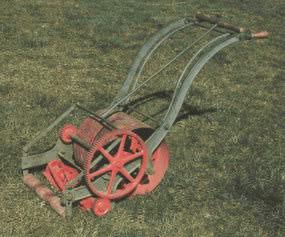![]()

![]()

The World's first lawnmower
So what was Edwin Budding's claim to fame. Well, our Edwin was a worker in a weaving mill, and he realised that the device which trimmed the pile on cloth in the factory could be adapted to cut other things - like grass. And the machine that Edwin Budding invented was the cylinder mower. The first models were introduced by Ransomes in 1832. Overnight keeping grass neatly cut became an unskilled and relatively speedy job. Scythes were old hat. There was a small model at 7 guineas "for a gentleman who wishes to use it himself" and a larger version at 10 guineas which was "preferable for use by hired gardeners."
Before Budding's invention there were various methods of keeping grass under control. In the Medieval lawn there had been 'much trampling and beating' to inhibit the grass from growing, and in the l8th century a variety of animals such as sheep and cows and even deer grazed the grass of the landscape garden around the grand houses of the day. This, of course, had the advantage of fertilizing the ground at the same time. But it was the scythe which quickly established itself as the standard mowing implement. The early guides recommended scything twice a year, but the British lawns of the 17th century were cut twice a month. This relatively frequent cutting created lawns which were the envy of overseas visitors. It did involve a great deal of hard work, which was no problem since somebody else was doing it. The turf was rolled a few days before scything, and after cutting a team of women gathered up and disposed of the clippings. What the average lawn looked like in those pre-mower days can only be left to the imagination. One author wrote that a good workman with a scythe "will leave it very nearly as smooth and even as the piece of green cloth which covers the table on which I am writing." A much closer description of the results of scything is probably that given by Budding in his patent - 'circular sears, inequalities and bare patches ..... which continue to be visible for several days'.
The introduction of the mower resulted in the rapid decline in the use of the scythe as a lawn tool. A scythe is not the easiest of implements to use, and needs a lot of practice to make a good job of cutting the grass instead of amputating the occasional leg. And, as usual, everybody climbed on the band wagon. There was a steady stream of new ideas, patents and improvements after 1830. The American 'Archimedean' mower appeared in Britain in the 1860s, bearing a single spiral blade and the revolutionary idea that cuttings should be left on the lawn as they would keep it 'fresh and green even in the hottest summer and this without any untidy appearance whatever'. Modern lawn mower manufacturers say the same thing today.
One of the most important developments was the introduction of alternative sources of power to relieve the problem of tired arms and aching backs. In 1842 the horse-drawn mower appeared. Fifty years later they were being driven by steam. In the first years of the 20th. century petrol-driven mowers were being used to cut the lawns of the well-to-do. But the ordinary gardener had to wait until the 1960s for the introduction of the lightweight electric mower and the launch of the hover mower by Flymo.
The character of the turf, what it looks like, how it wears, and how well it copes with periods of sustained rainfall or drought, depends on the species of grasses which are present, and the early text books warned against the use of ordinary farm grasses. So it is surprising that research into lawn grasses did not start until late into the 19th. century, and it was the golf craze which prompted these investigations. The first trials started in 1885 in America, and this work showed that bents and fescues were the best grasses for the luxury lawn. The first experimental turf garden was established in 1890, and quite quickly additional trial sites were created throughout the United States. As usual, research started even later in Britain, and again it was golf that started it. In 1924 the Green Committee of the Royal & Ancient Golf Club proposed that research into turf culture should be undertaken, and a research station was founded in 1929. Since then a lot of research has been done and continues to be done by all interested parties - seed producers and chemical and machinery manufacturers. Every year seems to bring new and better methods of cutting and feeding the grass, removing the weeds, controlling the diseases - every one designed to encourage the average gardener like you and me to part with his hard-earned cash. So, next time you find yourself walking backward and forward on your lawn behind your electrically powered lawn mower, spare a thought for Edwin Budding, and think of all the time and effort his invention has saved you.
Happy gardening.
written by Bill Hutchings
![]() Return to the Summer 1999 Features page
Return to the Summer 1999 Features page
![]() return to Home page and main index
return to Home page and main index
page last updated 1 JULY 1999